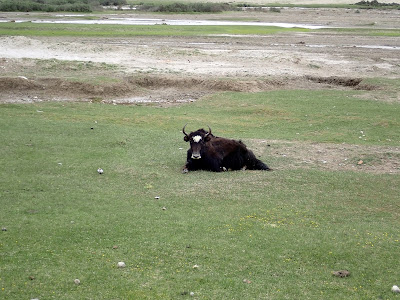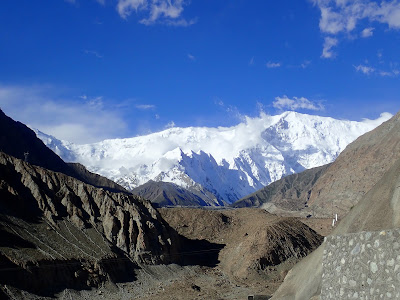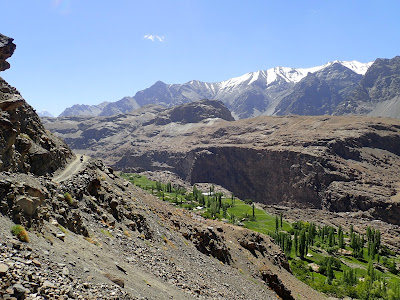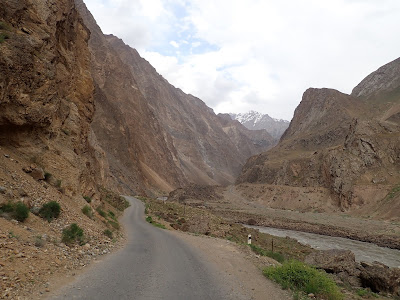June 22, 2018
We had camped only a few kilometres from the border, so we were there early before it opened. It was a cold morning and we employed the standard bike trick of sneaking to the front of the line, past the trucks. Once parked, we hung out in our puffy jackets, chatting with curious truckers while we waited for the border to open. Mustagh Ata loomed high above us, its summit brushing the clouds above 7500m.
Leaving Tajikistan was easy, just the usual formalities and passport stamping. The Chinese side was a bit more involved, but still not as invasive as we had been expecting. In contrast to the control zone on the Tajik side, the Chinese control zone is much stricter. We weren’t allowed to ride the 14km between the first checkpoint and the passport control office, so we hitched a ride with one of the truckers we had been chatting with earlier. They X-rayed all of our panniers but didn’t tear them apart, and despite hearing that it was mandatory, they didn’t search our phone or laptop. Unfortunately, they did confiscate all of our fruit and vegetables, as well as our eggs. This amounted to almost all of the food we had packed to make it to Kashgar, still over 200km away. We were left with a few packs of noodles, some crushed cookies, some sugar-coated peanuts and no local currency.
By early afternoon, we were through the border and on the Karakorum highway. The mountains here are just incredible, and we were riding on the smoothest pavement we’d seen since Turkey. The Chinese sure know how to build roads. Mustagh Ata still dominated the skyline, and after a very unwelcome climb, we started our final descent into Kashgar.
Still so high in the mountains, the views were unreal. Yaks and camels dotted the roadside and we tried not to think about our empty food pannier. Water was becoming an issue too, there was a stream next to the road but it was choked with garbage and looked pretty unappetizing. We eventually filled up from a small lake that looked a bit cleaner than anything else, despite the yak poop on the banks. Camping options were slim, and wild camping is actually illegal in Xinjiang, so we had to be extra cautious not to be seen. We ended up sleeping in a big storm drain underneath the highway, probably the least glamorous location imaginable for the final night of our trip.
In the morning we split our last package of instant noodles and continued our descent. With the climb straight out of the border we were still up above 4000m, despite some descending the previous day. We had a long way to go to Kashgar, down at 1200m. It ended up being one hell of a day. Our food stash was down to some cookie crumbs and a handful of peanuts, and our water was running low. We had no Chinese money and no way to get any. And, to be totally honest, we were just done. Done riding bikes, done camping, done mentally and physically. So, we decided to just go for it. As with all roads, it’s never all downhill, even when you’re descending 3000m in a day. There were some epic smooth descents where we flew around corners, leaning into turns like the bikes were extensions of our bodies. There was also a lot of flat or slightly uphill slogging. We were hungry and thirsty but the sudden increase in oxygen as we got lower made me feel amazing. I spent part of the day in a detached, trance-like state, where I felt like I had moved past the need for food or water. I was just pedaling, just riding; my existence in the moment was nothing more and nothing less.

By early afternoon, our water was long gone. Despite being high on oxygen, we were dangerously dehydrated and getting close to crashing. I had started eyeing the water in the ditch next to the road and wondering if I was that desperate. About 40km from Kashgar a car pulled over and a very happy man jumped out and handed Steve a water bottle. Steve chugged it, and showed the guy his empty bottles. Laughing, the guy reached into his car and handed us a few more bottles. He gestured enthusiastically to the bike that was jammed into his back seat, shook our hands, and drove off. How did we even get this lucky?
By the time we got to Kashgar we had ridden 168km that day, so eager to be finished biking that we had done it before 3pm. We checked into a hostel, parked the bikes... and that was it. There was no big fanfare, no huge arrival. One minute we were on a long, cross-continent bike tour, and then suddenly we were done.
Well, we weren’t quite done. We spent a week in Kashgar sorting out logistics, booking flights, and packing up the bikes. That time was also used to explore the city a bit. Steve had visited this place 10 years earlier, and was pretty shocked to see what had changed in that time. Many people have written about the current situation in Xinjiang with much more knowledge and insight than I will be able to muster. I’ll keep it pretty simple; there’s a scary amount of surveillance and police presence and control over who can move around the city. The Chinese government is essentially ethnic-cleansing its Uigher population, complete with “Re-education” camps and restrictions on any practices, clothing or grooming related to their religion or culture. It’s pretty horrifying. They’ve also bulldozed the original Old City and replaced it with a fake, Disneyland style “Old City”. It didn’t affect us much as tourists, we moved through all the checkpoints and past the roaming gangs of police thugs with no trouble. We’re not the ones they’re trying to control.
From Kashgar we flew to Chengdu, where we spent a few days being tourists without bikes, and then we flew home. My parents picked us up at the airport, and our trip was officially over.
It was a strange feeling to be back in Canada, surrounded by all the familiarity of home and a language we spoke fluently. It was even more surreal to think that just 2 weeks earlier we had been camping high on a remote plateau in the Pamirs, surrounded by wind and rocks and snow. And that quite a few of the people we had met over the last months were still out there, pedaling away, while we sat on the couch drinking coffee.
When we first set out from Iceland, there were so many questions about what lay ahead. We always do a ton of research and preparation so we know what’s coming, but there’s only so much you can prepare for. There are always so many unknowns. I had so many things on my mind, so many pieces of the puzzle floating around with nowhere yet to fit. I thought about the weather in Iceland. Wild camping in Europe. Riding in the winter. The Shengen Visa. Border crossings and safety, traffic and bad drivers. Landmines in Bosnia. Ferries in Greece. Crossing the Caspian Sea. Visas, money, food, and water. Desert crossings and limited supplies. Altitude. Camping on the Afghan border. Water levels in the Bartang. Staying healthy and strong and able to pedal. Which routes to choose? Which decisions were the right ones? Was this entire plan too dangerous and foolhardy to pull off? There were so many thoughts and plans and potential situations bouncing around in my head, taking up space and energy. Slowly, over the months we were riding, they disappeared. Each one surfaced as we came to it, and then faded as we dealt with it and moved to the next one. As we were nearing the end, especially after we had decided that it actually was the end, my mind felt so free. It was so satisfying, to look back and realize that every single doubt or concern was surmountable, and that we had figured it all out and pulled it off.
It has taken me almost 3 years to finish writing about our trip. We got busy and life happened, but the incomplete blog was always there, nagging in the back of my mind. One of the best things I did while riding is that I kept a journal, where I wrote a little bit about every single day we were gone. It’s the only way I was able to remember everything well enough to write about it now. It’s been fun re-reading my journal, looking at all the pictures, and re-living our days on the bikes.
We’d talked about doing this trip for a few years before getting around to it. After our first bike trip through Spain and West Africa, we had aspirations of tackling something a bit bigger. One night, Steve just said something along the lines of “life is so uncertain and you never know what will happen. If there’s something we want to do, we should do it now, before we can’t.” They were wise words, and it was the motivation we needed to make it happen.
Especially right now, with a global pandemic and various states of lockdown and travel restrictions around the world, I feel pretty fortunate that we were able to do this trip. Sure, we put a lot of effort into making it happen, but we also got very lucky, and benefited so much from the people we met. I think anyone who travels by bike will say that they receive so much generosity from strangers, and our trip was no exception. So many people helped us along the way, whether it was roadside snacks, a place to put our tent, or just a friendly wave as we passed. In addition to these small strokes of luck, we started out pretty lucky. It’s a huge amount of privilege to be able to put your entire life on hold and go for a really long bike ride. Not to mention having passports and a nationality that is welcomed and appreciated all over the world. It also helped knowing that back home, friends and family were following along and rooting for us.
We couldn’t have been happier with how it turned out, including all the highs and lows, and hard days when we wanted nothing more than to quit but somehow kept going. So many amazing things that we experienced didn’t even make it to the blog, because we could never include it all. We remain even more convinced that a bicycle is a wonderful way to travel. All this, plus being able to share it with my sister and her partner, who just so happened to be on a similar epic trip at the same time? Truly, we couldn’t have planned it better.
Since no post is complete without a roundup, here it is:
Iceland to China:
Starting point: Keflavik, Iceland – Oct 14 2017
Finishing point: Kashgar, China – June 22 2018
Total distance pedaled: 11,749 km
Distance traveled as a percentage of the circumference of the earth: 29.4%
Total days: 253; or 8.5 months
Number of Countries visited: 20
Number of Countries banned from: 26
Number of currencies used: 16
Most time spent in a country: 35 days (Turkey)
Least time spent in a country: 8 hours (Austria)
Highest point: 4655m (Ak Baital Pass, Tajikistan)
Lowest point: -28m (Caspian Sea)
Longest day: 168km (Our very last day, riding into Kashgar)
Top Speed: 82.7 km/h
Flat tires: 7 (3 for Steve, 4 for Elaine)
Crashes: 4 (1 for Steve, 3 for Elaine)
Number of Ferries taken: 9
Number of nights spent in the tent: 115
Coldest riding temperature: -8C
Hottest riding temperature: 52.8C
Top 3 hardest days:
- Day 245, climbing the switchbacks out of the Bartang Valley, Tajikistan.
- Day 248, Over Ak-Baital Pass to Murghab, Tajikistan.
- Day 123, Outrunning a storm to Sarande, Albania.
Best drivers: Poland
Worst drivers: Georgia
Cheapest beer: Sarajevo, Bosnia (2L for $1.50)
Most expensive beer: Torshavn, Faeroe Islands (a pint for $10)
Birthdays celebrated on the road: 2 (Dubrovnik for Steve, Uzbek desert for Elaine)
Most important item that we couldn’t survive without: Cookies.
Time between finishing the trip and finishing the blog: 1,034 days (almost 3 years)

































































